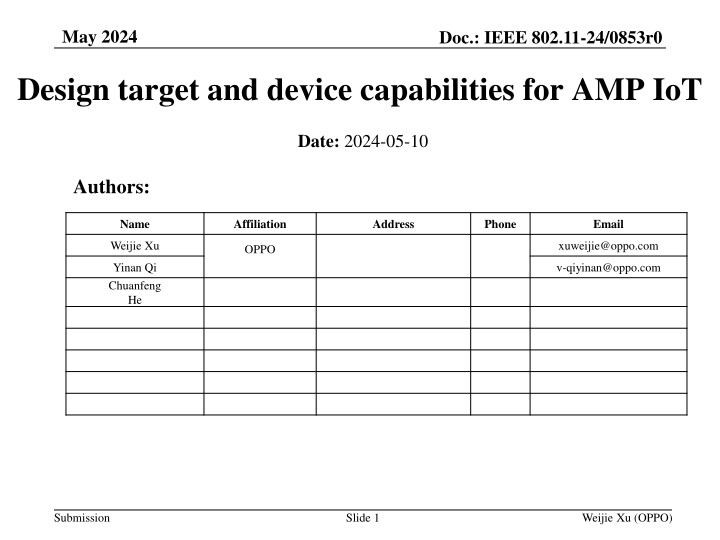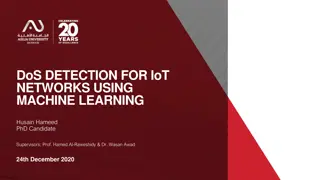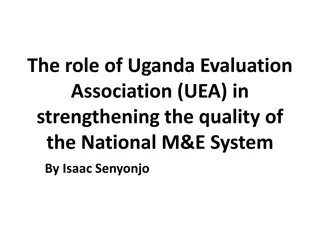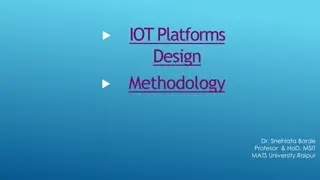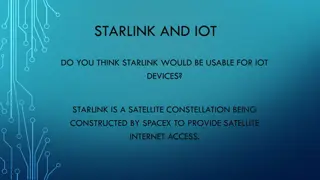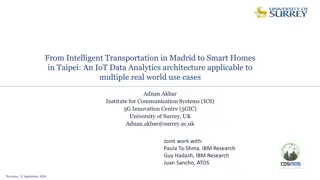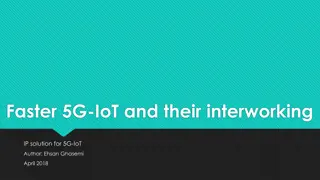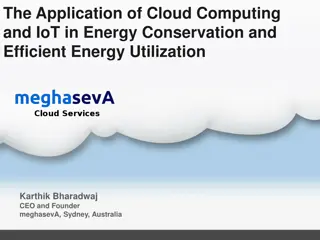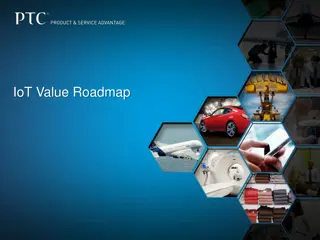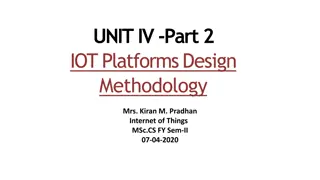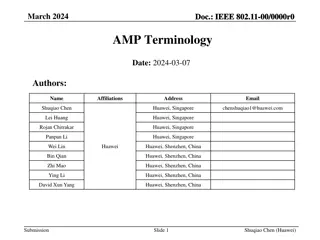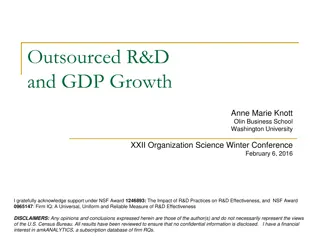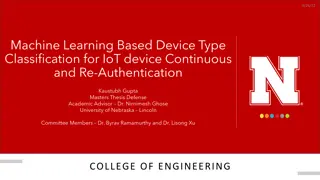Design target and device capabilities for AMP IoT
This submission discusses the design target of Ambient IoT (AMP IoT) and the device capabilities of AMP client STA. It explores use cases, requirements, and differentiation from existing technologies like WLAN IoT and RFID. The study identifies various scenarios and highlights the potential advantages of Ambient IoT over current solutions.
Download Presentation

Please find below an Image/Link to download the presentation.
The content on the website is provided AS IS for your information and personal use only. It may not be sold, licensed, or shared on other websites without obtaining consent from the author.If you encounter any issues during the download, it is possible that the publisher has removed the file from their server.
You are allowed to download the files provided on this website for personal or commercial use, subject to the condition that they are used lawfully. All files are the property of their respective owners.
The content on the website is provided AS IS for your information and personal use only. It may not be sold, licensed, or shared on other websites without obtaining consent from the author.
E N D
Presentation Transcript
May 2024 Doc.: IEEE 802.11-24/0853r0 Design target and device capabilities for AMP IoT Date: 2024-05-10 Authors: Name Affiliation Address Phone Email Weijie Xu xuweijie@oppo.com OPPO Yinan Qi Chuanfeng He v-qiyinan@oppo.com Submission Slide 1 Weijie Xu (OPPO)
Doc.: IEEE 802.11-24/0853r0 May 2024 Abstract This submission is to discuss the design target of AMP IoT and the device capabilities of AMP client STA. Submission Slide 2 Weijie Xu (OPPO)
November 2022 Doc.: IEEE 802.11-22/1960r2 Background: The target of the study[1] Remote metering, Sensors, Agriculture, Alarming, Security etc. Logistics, Retail, Supply chain, Clothing,etc. Manufacturing, Supply chain, Sensors, Smart Grid, Agriculture, Indoor positioning, Smart Home etc. Existing Cellular IoT/WLAN IoT AMP-IoT RFID Lower capabilities Higher capabilities RFID AMP IoT Existing WLAN IoT(e.g. 802.11 ah) Coverage <10 m 10m~30m (RF power); Up to 200m(other ambient power) >=1000m Power Source RF power only Various ambient power Battery Techniques RF power harvesting Backscattering Backscattering/Active transmitter WUR receiver Enhanced power saving Power management OFDM/Narrow bandwidth Relaxed processing eDRX(TWT) PS-Poll Energy limited operation Power Consumption 1uw~10uw <1mw 100x mw Device Cost (Relatively) Low Medium High Maintenance/operation cost Labor cost for operation Maintenance-free Automated operation Replace/Recharge the battery/Automated operation During TIG and SG, the design target of AMP IoT is proposed: AMP IoT should aim for the use cases that can t fully addressed by existing technologies. Submission Slide 3 Weijie Xu (OPPO)
May 2024 Doc.: IEEE 802.11-24/0853r0 Use cases and requirements Based on previous discussion during the TIG and SG phase, mainly 3 different use case scenarios have been identified for Ambient IoT. Use case scenario 1: Short/medium range Ambient IoT[2][3][4][5][6][7][8][9] Coverage: 10m~100m Need to process hundreds of AMP device each seconds Use case scenario 2: Close range Ambient IoT[10] Coverage: 20cm~50cm Process one AMP device at one time Use case scenario 3: Compatible Ambient IoT[11] Coverage: 10m~100m Be able to communicate with legacy WiFi network Submission Slide 4 Weijie Xu (OPPO)
May 2024 Doc.: IEEE 802.11-24/0853r0 What will differentiate Ambient IoT with existing technologies Compared with existing WALN IoT technologies: Battery-less, ultra-low complexity, small size, maintenance-free device etc. Compared with RFID: Potential longer range, via using - Advanced techniques such as reflection amplifier, spreading, UL coding etc. - Energy storage ( which help can lower energy harvesting threshold) - Other kinds of ambient power such as light, heat etc. Higher sensitivity receiver (with different receiver Arch.) Potential higher system capacity/system efficiency - Techniques such as FDM/CDM - Higher peak data rate? Lower deployment cost - Low-complexity AMP AP (e.g. by avoiding full-duplex operation) Enable more application, e.g. can link ambient IoT device with a smart phone - Submission Slide 5 Weijie Xu (OPPO)
May 2024 Doc.: IEEE 802.11-24/0853r0 Key capabilities of AMP STA The following capabilities are important for AMP STA: Receiver architecture Supported uplink transmission mechanism Supported waveform Whether have Energy storage Whether have Reflection amplifier Clock accuracy Submission Slide 6 Weijie Xu (OPPO)
May 2024 Doc.: IEEE 802.11-24/0853r0 DL receiver Generally, two receiver architectures can be used for Ambient IoT Option 1: RF envelope detector (RF ED) The receiving bandwidth can be tens of MHz. It is applicable with the existing WUS which has 4MHz signal bandwidth and 8MHz guard band on both lower and higher sides The achievable receiver sensitivity is -45~-35dBm, which is better than energy harvesting The power consumption is several W Figure: RF envelope detector Submission Slide 7 Weijie Xu (OPPO)
May 2024 Doc.: IEEE 802.11-24/0853r0 DL receiver Option 2: (Zero) IF Receiver Applicable using existing WUS design, and have much better receiver sensitivity, e.g. lower than -Y dBm. Y can be smaller than 82 in order to further reduce the complexity of receiver compared with 11ba WUR. The power consumption is hundreds of W Figure: (Zero) IF Receiver Both of RF envelope detector and (Zero) IF Receiver can be used for ambient IoT. Which one is used can be determined based on the applicable ambient power and the required coverage. Submission Slide 8 Weijie Xu (OPPO)
May 2024 Doc.: IEEE 802.11-24/0853r0 UL transmission Generally, two transmission mechanisms for Ambient IoT uplink. Option 1: Backscattering Option 1-1: without reflection amplifier The power consumption is several W Option 1-2: with reflection amplifier The power consumption is hundreds of W, dominated by that of reflection amplifier Option 2: Active transmission Power amplifier and local oscillator are needed The power consumption is several hundreds of W Although the power consumption of Option 2/1-2 is higher than that of Option 1- 1, it is still feasible for most of the use cases since uplink transmission is duty- cycle based and only take a very few percentage of whole operation time of the device. Slide 9 Submission Weijie Xu (OPPO)
May 2024 Doc.: IEEE 802.11-24/0853r0 Link budget WPT@920MHz, backscattering@2.4GHz WPT Frequency 920MHz EIRP of Energizer (dBm) 33 Communication frequency 2.4GHz EIRP of carrier wave@2.4GHz (20dBm) 20 Receiver sensitivity of AMP AP (dBm) -95 (Note 1) Antenna gain of AMP STA (dBi) 2 Shadowing factor 3dB@920MHz 4dB@2.4GHz Minimum receiving WPT power @AMP STA (dBm) -20 Maximum WPT distance(m) 10.33 Backscattering loss at IoT device (dB) 5 1.92 Maximum Backscattering distance (m) without reflection amplifier@ Maximum WPT distance Gain of reflection Amplifier factor (dB) 15 10.78 Maximum Backscattering distance (m) without reflection amplifier@ Maximum WPT distance Observation: In case of WPT@920MHz and backscattering communication @2.4GHz, reflection amplifier is needed. Submission Slide 10 Weijie Xu (OPPO)
May 2024 Doc.: IEEE 802.11-24/0853r0 Reflection amplifier Based on theoretical analysis and practical experiment, the achievable maximum gain of reflection amplifier is 10~15dB. It will become unstable with higher gain. Peak Detector Phase Controller DAGC Figure : reflection Amplifier (15dB gain, Power consumption:100uw[12]) Submission Slide 11 Weijie Xu (OPPO)
May 2024 Doc.: IEEE 802.11-24/0853r0 Waveform Different AMP STA device may have the capabilities to support different waveforms, especially in the uplink. While taking the difference of device capabilities into account, it needs to try to achieve a harmonized waveform as much as possible as proposed in [16]. In DL, MC-OOK is suitable for all devices. In UL, OOK will be suitable for AMP STA in close range AMP IoT and short/medium range AMP IoT. For legacy-compatible AMP IoT, OFDM can be used for both DL and UL after wake-up. Submission Slide 12 Weijie Xu (OPPO)
May 2024 Doc.: IEEE 802.11-24/0853r0 Energy storage For close range Ambient IoT, no need to have dedicated energy storage. The instant harvested power is sufficient to drive the AMP STA. DL data signal or DL carrier wave signal needs to be continuously send to the AMP STA to guarantee continuous power transfer. Instant/temporal (e.g. several us) power interrupt due to MC-OOK ON-OFF switch or channel fading can be tolerated by AMP STA since there is tiny capacitor in the energy harvesting circuit For short/medium range Ambient IoT and compatible Ambient IoT, dedicated energy storage is needed[13]. It can help to collect very weak ambient power and boost the peak power for AMP STA. It extend the coverage when RF power is used by lowering the energy threshold. The capacity of energy storage may depend on the type of ambient power, traffic period, coverage etc. It will based on implementation. Submission Slide 13 Weijie Xu (OPPO)
May 2024 Doc.: IEEE 802.11-24/0853r0 Clock accuracy of AMP STA(1) Due to the limited complexity and power consumption, the clock accuracy of AMP STA is worse than that of a legacy WLAN devices(20ppm). In addition, the clock accuracy of RFID device is 10^4~10^5 ppm[14]. The clock accuracy of 11ba WUR is 200ppm. Since the clock accuracy at the reader side can be guaranteed, the DL signal can provide clock reference for AMP STA to receive DL signal. For UL transmission, the device needs to generate the clock itself. Therefore, the required clock accuracy for DL receiving and UL transmission may be different. Submission Slide 14 Weijie Xu (OPPO)
May 2024 Doc.: IEEE 802.11-24/0853r0 Clock accuracy of AMP STA(2) For DL, for two different receiver types, the required clock accuracy will be different. For RF ED, although the initial clock accuracy can be 10^4~10^5, which is similar as that of RFID, AMP STA can still derive clock based on DL signal (e.g. based on its raising and falling edge of OOK signal, similar as RFID s implementation) For IF Rx, when receiving, a relatively good clock accuracy is needed for the AMP STA to convert the RF signal to an IF signal. 10^3 ppm is proposed. 10^3 ppm corresponds to a maximum frequency shift of 2.4MHz, the receiver sensitivity degradation (about 3dB due to doubled noise power) is acceptable considering the bandwidth of WUS is 4MHz. Compared with the 200ppm of 11ba WUR, it can further reduce the implementation requirement and the power consumption. It may slightly affect DL receiver sensitivity, but AMP IoT doesn t have to achieve the same coverage of legacy WiFi. Slide 15 Submission Weijie Xu (OPPO)
May 2024 Doc.: IEEE 802.11-24/0853r0 Clock accuracy of AMP STA(3) For AMP STA uplink transmission, the following clock accuracy is proposed: For close range use case, clock accuracy (i.e. SFO) is 10^4~10^5 ppm For AMP and RFID dual-mode device, reasonable to follow the capability of RFID device[11]. For short/medium range Ambient IoT, clock accuracy is <10^3 ppm Based on the proposed value in [15] and the practical experience, it is very feasible to achieve such accuracy with some calibration method and only very few power consumption for calibration. For legacy-compatible AMP IoT, For main radio, reuse 20ppm or one relaxed value (to reduce the power consumption) can be considered. For WUR to receive the wake-up signal, clock accuracy is <10^3 ppm or 200ppm. Submission Slide 16 Weijie Xu (OPPO)
May 2024 Doc.: IEEE 802.11-24/0853r0 Summary of device capabilities of AMP client STA Use case Short/Medium range AMP IoT Close range AMP IoT Compatible AMP IoT (i.e. 11n compatible) ULTransmitter Active Tx Backscattering Backscattering Legacy OFDM Tx UL Amplifier Y(May) Y (Reflection) N Y(Legacy) DL Amplifier Y(May) Y(May) N Y(Legacy) Y(Opt 1) Y(Opt1) Y Y for wake-up RF ED Rx Sens. of ~-40dB (Zero-) IF Rx: sens. of ~-70dB Y(Opt 2) Y(Opt2) N OFDM receiver after wake-up Energy storage Y Y N Y IF Rx and UL:<10^3 ppm RF ED :10^4~10^5 ppm Clock accuracy 10^4~10^5 ppm <10^3 ppm for WUR ~20ppm for MR DL: MC-OOK UL:OOK/BPSK Waveform MC-OOK for wake-up, then OFDM Power consumption 100X W 100X W X W X mW~10X mW Submission Slide 17 Weijie Xu (OPPO)
May 2024 Doc.: IEEE 802.11-24/0853r0 Summary and proposals Propose to support the following PHY modes in 802.11bp with the device capabilities in slides 17: One low power receiving mode with Rx sensitivity of [-40]dB or [-70]dB SFO can be 10^4~10^5 ppm or <10^3 ppm One low power active transmission mode with uplink CFO(carrier frequency offset) of <10^3 ppm One backscattering mode with uplink SFO of 10^4~10^5 ppm or <10^3 ppm Submission Slide 18 Weijie Xu (OPPO)
May 2024 Doc.: IEEE 802.11-24/0853r0 Reference 1. IEEE 802.11-22/1960r6 2. IEEE 802.1122/1339r0, Use Cases of smart manufacturing 3. IEEE 802.1122/1341r1, Use Cases of Data Center Infrastructure Management. 4. IEEE 802.11-22/0963r0, Use Cases for AMP IoT Devices. 5. IEEE 802.11-22/1559, Updated Use Cases for AMP IoT Devices. 6. IEEE 802.11-22/1800r0, New Use Case for AMP IoT Devices: Smart Grid 7. IEEE 802.11-22/2133r0, New Use Case for AMP IoT Devices 8. IEEE 802.11-23/1192r0 Distributed Microphone Smart Home Application for AMP IoT devices 9. IEEE 802.11-23/1521r0 AMP Use Case in Smart Photovoltaics 10. IEEE 802.11-23/2038r0 Close-range AMP Backscattering in 2.4GHz 11. IEEE 802.11-23/1195r0 Thoughts on AMP IOT and PAR 12. IEEE 802.11-22/1893r0 Ambient Power Enabled IoT Technologies 13. IEEE 802.11-22/1799r0 On energy harvesting and the differentiation with RFID 14. Specification for RFID Air Interface Protocol for Communications at 860 MHz 960 MHz 15. IEEE 802.11-23/1140r0 Considerations for AMP Devices 16. IEEE IEEE 802.11-24/0849r0 Harmonization of Waveform Submission Slide 19 Weijie Xu (OPPO)
